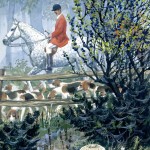From 6 October 2012 until 14 April 2013 an exhibition at the Museum of English Rural Life presents a range of different responses to a single illustration of rural life. It focuses on a small watercolour by the artist Charles F. Tunnicliffe.
This was one of many artworks created by him for Ladybird children’s books. The painting featured in What to Look For in Autumn, published in 1960. This was part of a four-book series printed between 1959 and 1961. It was written by the biologist Elliot Lovegood Grant Watson and charted seasonal change in the countryside.
The original Ladybird artwork is held alongside the collections of the Museum of English Rural Life at the University of Reading. This juxtaposition inspired us to invite specialists to examine a countryside image. Their responses form the core of the exhibition and together offer different answers to the question of What to Look For. They reveal the diverse stories that one illustration can tell.
Here we intend to ask how you might choose to look at this image and read the accompanying text? Are you interested in the artist, the illustration or other artistic responses? Perhaps the written word is more important. Maybe histories of science, of childhood or of hunting are more inspiring to you. What of the design of the book, its role in reading and learning, and how it teaches us to see and think about the world? As the exhibition progresses we hope that you will share your responses and join the conversation here.
What to Look For? Ladybird, Tunnicliffe, and the hunt for meaning
6 October 2012 until 14 April 2013
Dr Ollie Douglas (Museum of English Rural Life) and Dr Neil Cocks (Department of English Language and Literature)

